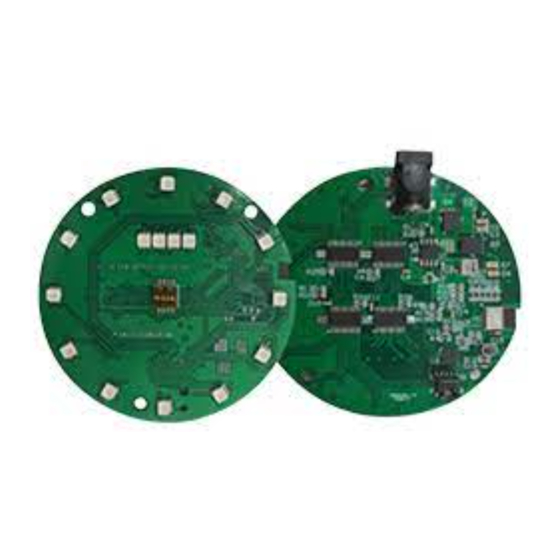
Advertisement
Quick Links
SECO-NCV7685RGB-GEVB
NCV7685 RGB Lighting
Evaluation Board User's
Manuals
Description
SECO−NCV7685RGB−GEVB is an evaluation board for RGB
LEDs lighting application with BLE in automotive which driven by
NCV7685 and controlled by RSL10. It is also an interior or exterior
lighting reference design for tail or ambient lights to realize general
sequential or high end pixelated LEDs controlling in−vehicle network.
The user can set RGB LED's color and intensity by mobile APP to
show customized information or animation.
In general, the user prefers to use fixed address in multiple
NCV7685 applications. It leads to additional procedure to
pre−program each chips' address in mass production stage. In
addition, it is inconvenient for maintenance in the aftermarket. In
firmware of this evaluation board, it uses floating address setting
method, each time when power on the board, NCV7685 will be
assigned an address which is defined by user, but it's not locked into
OTP registers. The user can realize this function by using either
RSL10's GPIO or IO expender (PAC9655).
In firmware, the driver APIs are divided into four levels: Peripheral,
Chip, Board and customer application. User can directly include the
chips and board APIs in their own project, and modify the application
APIs according to their applications. This will accelerate developing
period to market.
The board conceived for use as a plug and play environment to
testing.
Nominal supply voltage is 12 V (Supply voltage range 12−24 V). In
switch mode, four fixed animations shown; the RGB LEDs' color and
intensity setting by user mobile APP in BLE mode.
Features
•
Plug and Play; Switch and BLE Mode to Show Animations
•
16 RGB LEDs (48 Channels), each Current Programmable Sources
up to 60 mA
•
Independent PWM Duty Cycle Control for each Channel
•
On−Chip 150, 300, 600 and 1200 Hz PWM
•
Logarithmic or linear independent PWM dimming
•
Diagnostic and Protection against Open Load and Under−Voltage,
Over Temperature...
•
Dynamic Addressing Method for No−Worries in mass production
•
®
Bluetooth
5 Certified with LE 2M PHY Support
•
Rx Sensitivity (Bluetooth Low Energy Mode, 1 Mbps): −94 dBm
•
Transmitting Power: −17 to +6 dBm
•
Arm Cortex−M3 Processor and LPDSP32
•
AEC−Q100 Qualified and PPAP Capable
© Semiconductor Components Industries, LLC, 2020
May, 2020 − Rev. 1
EVAL BOARD USER'S MANUAL
1
www.onsemi.com
Publication Order Number:
EVBUM2713/D
Advertisement

Summary of Contents for ON Semiconductor SECO-NCV7685RGB-GEVB
- Page 1 SECO-NCV7685RGB-GEVB NCV7685 RGB Lighting Evaluation Board User's Manuals Description www.onsemi.com SECO−NCV7685RGB−GEVB is an evaluation board for RGB LEDs lighting application with BLE in automotive which driven by EVAL BOARD USER’S MANUAL NCV7685 and controlled by RSL10. It is also an interior or exterior lighting reference design for tail or ambient lights to realize general sequential or high end pixelated LEDs controlling in−vehicle network.
- Page 2 SECO−NCV7685RGB−GEVB Architecture and Key Parts Figure 1. Board Architecture KEY PARTS Chip Part Description NCV7685 12 Channels 60 mA LED Linear Current Driver I2C Controllable for Automotive RSL10 SIP System−in−Package, Bluetooth 5 Certified PCA9655 Remote 16−bit I/O Expander for I2C Bus with Interrupt NCV8170 Ultra‐Low IQ 150 mA CMOS LDO Regulator NCV891330...
- Page 3 SECO−NCV7685RGB−GEVB Figure 2. Top and Bottom Layer and Key Components Operations of NCV7685 RGB LEDs Board board shows four kinds of fixed animations or turns into After power on, the board shows the “Welcome” BLE mode. The functions and operations descripted as animation, then according to the setting of the switch, the below figures: Figure 3.
- Page 4 SECO−NCV7685RGB−GEVB Switch Setting: Figure 4. Status Indicator Mode Status Indicator Mode: Switch Setting: Keep all Switches off; the board comes into status indicator mode. Green means good, orange means warning and red means error. The color of LEDs changes in gradient from green to orange, then to red;...
- Page 5 SECO−NCV7685RGB−GEVB BLE Mode 800080FF00: LED0 in Purple Keep Switch S4 on and never mind of the setting of S2, S3, FF00003F01: LED1 in Red S4, the board turns into BLE mode. User can use general XXXXXX0010: All LEDs turn off as the he intensity is 0 mobile App to control LED’s color and intensity for (Never mind RGB’s values) individual or all LEDs.
- Page 6 SECO−NCV7685RGB−GEVB Firmware Setting Generally, floating address method is used in firmware; the configurations can changed in the “ncv7685.h” file. Here are options: 1. Floating Address method using SOC GPIO: #define NCV7675_CHIPS_NUM 0x04 /* Chips number #define PCA9655_Address 0x22 /* PCA9655 I2C address */ #define BY_SOC /* SOC or PCA9655 #define BY_PCA9655...
- Page 7 SECO−NCV7685RGB−GEVB Flow Chart of App.c Figure 12. Flow chart of App.c www.onsemi.com...
- Page 8 SECO−NCV7685RGB−GEVB Schematic Figure 13. Schematic of Board www.onsemi.com...
- Page 9 SECO−NCV7685RGB−GEVB Assembly Figure 14. Bottom Side Assembly www.onsemi.com...
- Page 10 Capacitors, 1206 − 10 V, 10 mF WCAP−CSGP Ceramic Capacitors, 1206 − 10 V, 100 nF WCAP−CSGP Ceramic Capacitors, 1206 ON Semiconductor BAS16H Schottky Barrier Diode, D3, D4 ON Semiconductor NTS560 Trench Schottky Rectifier, Low Forward Voltage, 60 V, −...
- Page 11 LIMITATIONS OF LIABILITY: ON Semiconductor shall not be liable for any special, consequential, incidental, indirect or punitive damages, including, but not limited to the costs of requalification, delay, loss of profits or goodwill, arising out of or in connection with the board, even if ON Semiconductor is advised of the possibility of such damages. In no event shall ON Semiconductor’s aggregate liability from any obligation arising out of or in connection with the board, under any theory of liability, exceed the purchase price paid for the board, if any.

Need help?
Do you have a question about the SECO-NCV7685RGB-GEVB and is the answer not in the manual?
Questions and answers